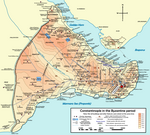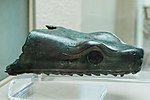Palace of Antiochos
Buildings and structures completed in the 5th centuryByzantine palacesChurches and monasteries of ConstantinopleConstantinople
The Palace of Antiochos (Greek: τὰ παλάτια τῶν Ἀντιόχου) was an early 5th-century palace in the Byzantine capital, Constantinople (modern Istanbul, Turkey). It has been identified with a palatial structure excavated in the 1940s and 1950s close to the Hippodrome of Constantinople, some of whose remains are still visible today. In the 7th century, a part of the palace was converted into the church–more properly a martyrion, a martyr's shrine–of St Euphemia in the Hippodrome (Ἀγία Εὐφημία ἐν τῷ Ἱπποδρομίῳ, Hagia Euphēmia en tō Hippodromiō), which survived until the Palaiologan period.
Excerpt from the Wikipedia article Palace of Antiochos (License: CC BY-SA 3.0, Authors).Palace of Antiochos
Binbirdirek Meydanı Sokağı, Istanbul
Geographical coordinates (GPS) Address Nearby Places Show on map
Geographical coordinates (GPS)
| Latitude | Longitude |
|---|---|
| N 41.0074 ° | E 28.9751 ° |
Address
İstanbul Adalet Sarayı
Binbirdirek Meydanı Sokağı
34122 Istanbul
Türkiye
Open on Google Maps








